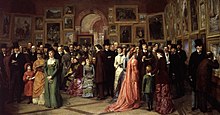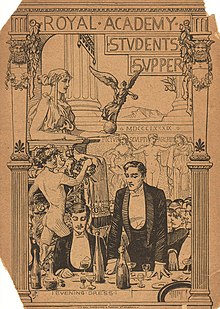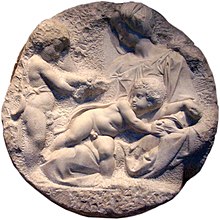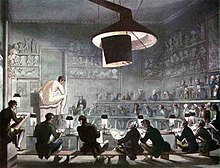Can You Teach After Attending the Royal Academy of Arts
Coordinates: 51°thirty′33″Northward 0°08′22″W / 51.50917°N 0.13944°Due west / 51.50917; -0.13944
 Front view, August 2009 | |
 | |
| Established | 1768 (1768) |
|---|---|
| Location | Piccadilly London, W1, England, United Kingdom |
| Visitors | 1,285,595 (every bit of 2016) [i] |
| President | Rebecca Salter |
| Public transit access | |
| Website | royalacademy.org.uk |
The Royal University of Arts (RA) is an fine art establishment based in Burlington House on Piccadilly in London. Founded in 1768, it has a unique position equally an independent, privately funded institution led past eminent artists and architects. Its purpose is to promote the creation, enjoyment and appreciation of the visual arts through exhibitions, education and debate.
History [edit]

A modern analogy of Burlington House in London, home of the Royal University of Arts
The origin of the Royal Academy of Arts lies in an endeavour in 1755 by members of the Society for the Encouragement of Arts, Articles and Commerce, principally the sculptor Henry Cheere, to found an autonomous academy of arts. Prior to this a number of artists were members of the Club for the Encouragement of Arts, Manufactures and Commerce, including Cheere and William Hogarth, or were involved in small individual art academies, such equally the St Martin's Lane Academy.[2] Although Cheere'southward attempt failed, the eventual charter, chosen an 'Instrument', used to establish the Royal Academy of Arts over a decade afterwards was almost identical to that fatigued up by Cheere in 1755.[iii]
The success of St Martin'southward Lane Academy led to the formation of the Social club of Artists of Smashing Britain and the Free Society of Artists.[4] Sir William Chambers, a prominent architect and caput of the British government's architects' department, the Office of Works, used his connections with King George Three to gain imperial patronage and financial support for the University.[v] The Royal Academy of Arts was founded through a personal act of King George III on ten December 1768 with a mission "to found a schoolhouse or academy of blueprint for the use of students in the arts" with an annual exhibition.[6]

The painter Joshua Reynolds was made its first president,[7] and Francis Milner Newton was elected the first secretarial assistant,[8] a post he held for two decades until his resignation in 1788.[ix]
The instrument of foundation, signed by George Iii on 10 Dec 1768, named 34 founder members and immune for a total membership of 40. The founder members were Reynolds, John Baker, George Barret, Francesco Bartolozzi, Giovanni Battista Cipriani, Augustino Carlini, Charles Catton, Mason Chamberlin, William Chambers, Francis Cotes, George Dance, Nathaniel Trip the light fantastic, Thomas Gainsborough, John Gwynn, Francis Hayman, Nathaniel Hone the Elder, Angelica Kauffman, Jeremiah Meyer, George Michael Moser, Mary Moser, Francis Milner Newton, Edward Penny, John Inigo Richards, Paul Sandby, Thomas Sandby, Dominic Serres, Peter Toms, William Tyler, Samuel Wale, Benjamin W, Richard Wilson, Joseph Wilton, Richard Yeo, Francesco Zuccarelli.[10] William Hoare and Johann Zoffany were added to this list by the King in 1769.[10]

Study for Henry Singleton's painting The Royal Academicians assembled in their quango chamber to adjudge the Medals to the successful students in Painting, Sculpture, Architecture and Cartoon, which hangs in the Royal University. Ca. 1793.
The Regal Academy was initially housed in cramped quarters in Drapery Mall, although in 1771 information technology was given temporary accommodation for its library and schools in Old Somerset House, then a imperial palace.[eleven] In 1780 information technology was installed in purpose-built apartments in the first completed fly of New Somerset Firm, located in the Strand and designed by Chambers, the Academy'due south starting time treasurer.[eleven] The Academy moved in 1837 to Trafalgar Square, where it occupied the east wing of the recently completed National Gallery (designed past another Academician, William Wilkins).[12] These premises presently proved besides small to firm both institutions. In 1868, 100 years subsequently the Academy'southward foundation, it moved to Burlington House, Piccadilly, where it remains.[thirteen]
The first Royal University exhibition of contemporary art, open to all artists, opened on 25 April 1769 and ran until 27 May 1769. 136 works of art were shown and this exhibition, now known as the Royal Academy Summer Exhibition, has been staged annually without interruption to the present twenty-four hours. Following the cessation of a similar annual exhibition at the British Institution, the Academy expanded its exhibition program to include a temporary annual loan exhibition of Former Masters in 1870.[14]
Great britain's first public lectures on fine art were staged past the Royal Academy, as some other way to fulfil its mission. Led past Reynolds, the kickoff president, the first program included a lecture past Dr. William Hunter.[xv]
In 2018, the Academy'southward 250th anniversary, the results of a major refurbishment were unveiled. The project began on one Jan 2008 with the appointment of David Chipperfield Architects. Heritage Lottery Fund support was secured in 2012. On 19 October 2016 the RA's Burlington Gardens site was airtight to the public and renovations commenced. Refurbishment work included the restoration of 150 sash windows, glazing upgrades to 52 windows and the installation of two large roof lights.[16] The "New RA" was opened to the public on xix May 2018. The £56 million development includes new galleries, a lecture theatre, a public project infinite for students and a bridge linking the Burlington House and Burlington Gardens sites. Every bit part of the process 10,000 works from the RA's collection were digitised and made available online.[17] [18]
Activities [edit]


Charitable status [edit]

The Purple Academy receives funding from neither the Land nor the Crown, and operates every bit a charity.[19] The RA's habitation in Burlington Firm is owned by the U.k. government and provided to the Academy on a peppercorn rent leasehold of 999 years.[20]
Permanent collection and loans [edit]
One of its principal sources of acquirement is hosting a programme of temporary loan exhibitions. These are comparable to those at the National Gallery, the Tate Gallery and leading fine art galleries outside the Great britain. In 2004 the highlights of the Academy's permanent drove went on brandish in the newly restored reception rooms of the original section of Burlington Business firm, which are now known equally the John Madejski Fine Rooms.[21]
Exhibitions [edit]
Under the direction of the sometime exhibitions secretary Norman Rosenthal, the Academy has hosted ambitious exhibitions of gimmicky art. In its 1997 "Awareness," it displayed the collection of work by Immature British Artists owned by Charles Saatchi. The show was controversial for its display of Marcus Harvey's portrait of Myra Hindley, a bedevilled murderer. The painting was vandalised while on display.[22]
In 2004, the Academy attracted media attention for a series of financial scandals and reports of a feud between Rosenthal and other senior staff. These problems resulted in the counterfoil of what were expected to take been profitable exhibitions.[23] In 2006, it attracted the press by erroneously placing only the support for a sculpture on display, then justifying it existence kept on display.[24]
Summertime exhibition [edit]
The Academy also hosts an almanac Purple Academy Summertime Exhibition of new art, which is a well-known issue on the London social calendar. Tracey Emin exhibited in the 2005 show. In March 2007 Emin accustomed the Academy's invitation to become a Royal Academician, commenting in her weekly newspaper column that, "Information technology doesn't mean that I take become more conformist; it means that the Royal Academy has become more open, which is healthy and vivid."[25]
Friends programme [edit]
In 1977 Sir Hugh Casson founded the Friends of the Royal Academy, a charity designed to provide financial support for the establishment.[26]
Literary collaborations [edit]
Pivot Drop Studio hosts alive events where well-known authors, actors and thinkers read a short story chosen as a response to the main exhibition program. The literary evenings are hosted by Pin Driblet Studio founder Simon Oldfield. Guests have included Graham Swift, Sebastian Faulks, Lionel Shriver, William Boyd, Will Self, Dame Eileen Atkins, Dame Sian Phillips, Lisa Dawn and Ben Okri.[27]
The RA and Pin Drib Short Story Award is an open submission writing prize, held annually along similar principles of the Royal Academy Summer Exhibition. The award ceremony features a alive reading of the winning story in its entirety by a special invitee. Past winning stories have been read by Stephen Fry, Dame Penelope Wilton, Juliet Stevenson and Gwendoline Christie.[28]
Presidents and officers [edit]
On x December 2019, Rebecca Salter was elected the first female President of the Purple University[29] on the retirement of Christopher Le Brun.[30]
In September 2007, Sir Charles Saumarez Smith became Secretary and Principal Executive of the Royal Academy, a newly created postal service.[31] Saumarez Smith stepped downward from the role at the terminate of 2018, and it was announced that Axel Rüger, manager of the Van Gogh Museum in Amsterdam, would fill the position from June 2019.[32]
Regal Academy Schools [edit]
The Royal Academy Schools form the oldest art schoolhouse in United kingdom, and have been an integral part of the Royal Academy of Arts since its foundation in 1768. A key principle of the RA Schools is that their three-yr mail service graduate plan is gratuitous of charge to every applicant offered a place.[33]

Majestic Academy Students Supper 1889. Front page of menu.
The Royal Academy Schools was the first institution to provide professional person training for artists in Britain. The Schools' program of formal training was modelled on that of the French Académie de peinture et de sculpture, founded by Louis XIV in 1648. It was shaped by the precepts laid down by Sir Joshua Reynolds. In his fifteen Discourses delivered to pupils in the Schools between 1769 and 1790, Reynolds stressed the importance of copying the Old Masters, and of drawing from casts later on the Antiquarian and from the life model. He argued that such a training would course artists capable of creating works of high moral and artistic worth. Professorial chairs were founded in Chemistry, Beefcake, Ancient History and Aboriginal Literature, the latter two being held initially past Samuel Johnson and Oliver Goldsmith.[34]
In 1769, the first yr of operation, the Schools enrolled 77 students. By 1830 over 1,500 students had enrolled in the Schools, giving an average intake of 25 students each year. They included men such as John Flaxman, J. M. West. Turner, John Soane, Thomas Rowlandson, William Blake, Thomas Lawrence, Decimus Burton,[35] John Constable, George Hayter, David Wilkie, William Etty, Edwin Landseer. and Charles Lucy in 1838.[36] The first woman to enrol as a student of the Schools was Laura Herford in 1860.[37] Charles Sims was expelled from the Schools in 1895.[38] The Regal Academy made Sir Francis Newbolt the first Honorary Professor of Constabulary in 1928.[39] [xl]
In 2011 Tracey Emin was appointed Professor of Cartoon,[41] and Fiona Rae was appointed Professor of Painting – the beginning women professors to exist appointed in the history of the Academy.[42] Emin was succeeded by Michael Landy,[43] and and so David Remfry in 2016 while Rae was succeeded by Chantal Joffe in Jan 2016.[44]
Library, archive, and collections [edit]
The starting time president of the Imperial University, Sir Joshua Reynolds, gave his noted self-portrait, get-go the Royal University collection. This was followed past gifts from other founding members, such as Gainsborough and Benjamin Westward. Subsequently, each elected Member was required to donate an artwork (known every bit a "Diploma Work") typical of his or her artistic output, and this practise continues today. Additional donations and purchases have resulted in a collection of approximately a k paintings and a thou sculptures, which testify the development of a British School of fine art. The Academy's collection of works on paper includes significant holdings of drawings and sketchbooks by artists working in Britain from the mid-18th century onwards, including George Romney, Lord Leighton and Dame Laura Knight.[45]
The photographic collection consists of photographs of Academicians, landscapes, architecture and works of art. Holdings include early portraits by William Lake Price dating from the 1850s, portraits by David Wilkie Wynfield and Eadweard Muybridge's Beast Locomotion (1872–85).[46]
Wall and ceiling paintings [edit]
Amid the paintings decorating the walls and ceilings of the edifice are those of Benjamin W and Angelica Kauffman, in the entrance hall (Hutchison 1968, p. 153), moved from the previous building at Somerset House. In the centre is West's roundel The Graces Unveiling Nature, c. 1779,[47] surrounded by panels depicting the elements, Fire, Water, Air and Earth.[48] At each end are mounted two of Kauffman's circular paintings, Composition at the west end, and Painting or Colour and Genius or Invention at the e end.[49]
Michelangelo'south Taddei Tondo [edit]

The Virgin and Kid with the Baby St John
The nearly prized possession of the Academy's collection is Michelangelo's Taddei Tondo, left to the Academy by Sir George Beaumont. The Tondo is unremarkably on display in the Collection Gallery, which opened in May 2018. Carved in Florence in 1504–06, information technology is the merely marble by Michelangelo in the United Kingdom and represents the Virgin Mary and child with the infant St John the Baptist.[fifty]
War memorials [edit]
In the entrance portico are two war memorials. One is in memory of the students of the Royal Academy Schools who fell in World War I[51] and the second commemorates the 2,003 men of the Artists Rifles who gave their lives in that war with a farther plaque to those who died in Globe State of war Ii.[52]
Membership [edit]

Life at the Royal University of Arts, from Microcosm of London, c. 1808
Membership of the Royal Academy is composed of upwards to 80 practising artists, each elected past ballot of the General Assembly of the Royal University, and known individually every bit Royal Academicians (RA). The Royal Academy is governed by these Royal Academicians. The 1768 Instrument of Foundation immune full membership of the Regal Academy to exist twoscore artists. Originally engravers were completely excluded from the university, but at the outset of 1769 the category of Associate-Engraver was created. Their number was limited to six, and unlike other associates, they could not exist promoted to full academicians.[53] In 1853 membership of the Academy was increased to 42, and opened to engravers. In 1922, 154 years later on the founding of the Royal Academy, Annie Swynnerton became the first woman ARA.[54]
Run across also [edit]
- 6 Burlington Gardens
- Cork Street, behind the Royal Academy, with many art galleries
- List of Purple Academicians
- Majestic W of England Academy
- Category:Imperial Academicians
References [edit]
- ^ "Visitor Figures 2016" (PDF). The Fine art Newspaper Review. April 2017. p. xiv. Retrieved 23 March 2018.
- ^ Hodgson & Eaton 1905, p. seven.
- ^ Gordon Sutton, Artisan or Creative person?: A History of the Teaching of Art and Crafts in English Schools (London: Pergamon Printing, 2014) p.297
- ^ Hodgson & Eaton 1905, p. x.
- ^ Chapter eleven, The Purple University, Sir William Chambers Knight of the Polar Star, John Harris, 1970, A. Zwemmer Ltd
- ^ Hodgson & Eaton 1905, p. 11.
- ^ Hodgson & Eaton 1905, p. 14.
- ^ Hodgson & Eaton 1905, p. 8.
- ^ Hodgson & Eaton 1905, p. 96.
- ^ a b Hodgson & Eaton 1905, p. 353.
- ^ a b Hodgson & Eaton 1905, p. 13.
- ^ Hodgson & Eaton 1905, p. 320.
- ^ "Burlington House | Survey of London: volumes 31 and 32 (pp. 390–429)". British-history.ac.uk. Retrieved 26 March 2013.
- ^ "Exhibition of the works of Old Masters". Regal Academy; Printed past William Clowes and Sons. 1870.
- ^ Kemp Thou (Jan 1992). "True to their natures: Sir Joshua Reynolds and Dr William Hunter at the Majestic Academy of Arts". Notes and Records of the Royal Society of London. 46 (1): 77–88. doi:10.1098/rsnr.1992.0004. PMID 11616172. S2CID 26388873.
- ^ "Imperial Academy of Arts". TRC Windows . Retrieved 30 September 2021.
- ^ "The New RA Now open". royalacademy.org.britain . Retrieved thirteen February 2019.
- ^ Thompson, Jessie (14 May 2018). "The Royal University of Arts gets a new look: Everything you demand to know about £56m redevelopment". Evening Standard. Retrieved 13 February 2019.
- ^ "The Royal Academy Of Arts". Charity Committee. Retrieved 25 July 2020.
- ^ "Lease of Burlington House". Royal University of Arts. Retrieved 25 July 2020.
- ^ "Fine Rooms are trading up". Evening Standard. 12 March 2004. Retrieved 25 July 2020.
- ^ "Myra – Fine art Crimes". Archived from the original on 2 March 2015. Retrieved five September 2016.
- ^ Higgins, Charlotte (10 June 2004). "Feud at meridian 'tearing Purple Academy apart'". The Guardian. London. Retrieved 7 March 2007.
- ^ BBC (14 June 2006). "Empty plinth sidelines sculpture". BBC News . Retrieved 7 March 2007.
- ^ Emin, Tracey. "I tin can run across that the Ra-Ra club is going to be a lot of fun", The Contained, thirty March 2007
- ^ "Friends of the Majestic Academy". Clemency Commission. Retrieved 25 July 2020.
- ^ "Podcast: Pin Drop with Ben Okri | Royal Academy of Arts". world wide web.royalacademy.org.uk . Retrieved 2 May 2018.
- ^ "Regal Academy & Pin Driblet Short Story Award | The Bookseller". www.thebookseller.com . Retrieved 7 March 2018.
- ^ "Rebecca Salter Becomes Twenty-Seventh President of The Royal Academy". Artlyst.
- ^ "Christopher Le Brun Royal Academy President To Step Down". Artlyst. 26 September 2019. Retrieved 25 July 2020.
- ^ Kennedy, Maev (28 March 2007). "Gallery manager quits subsequently policy tussle". The Guardian. London. Retrieved 30 March 2007.
- ^ correspondent, Marking Brown Arts (13 February 2019). "Axel Rüger leaves Van Gogh backside to head Imperial Academy". The Guardian. ISSN 0261-3077. Retrieved 4 March 2019.
- ^ "Majestic University Schools Prospectus | Royal Academy of Arts". world wide web.royalacademy.org.u.k..
- ^ "Oliver Goldsmith". Purple Academy of Arts. Retrieved 25 July 2020.
- ^ Arnold, Dana. "Burton, Decimus". Oxford Lexicon of National Biography (online ed.). Oxford Academy Printing. doi:10.1093/ref:odnb/4125. (Subscription or Great britain public library membership required.)
- ^ "Charles Lucy (1814-1873), Victorian Art History". www.avictorian.com . Retrieved seven June 2019.
- ^ Yeldham, Charlotte (2004). "Herford, Anne Laura". Oxford Dictionary of National Biography (online ed.). Oxford University Press. doi:10.1093/ref:odnb/69105. (Subscription or United kingdom of great britain and northern ireland public library membership required.)
- ^ Reynolds, Simon. "Sims, Charles Henry (1873–1928)" in Oxford Lexicon of National Biography, Oxford University Press, 2004.
- ^ "Sir Francis Newbolt (1863 - 1940)". Purple Academy of Arts . Retrieved 16 Nov 2021.
- ^ "SIR F.Thou. NEWBOLT, ATTORNEY, 77, DEAD;". New York Times. 8 December 1940.
- ^ "Tracey Emin to become a professor". 14 December 2011 – via www.bbc.co.great britain.
- ^ "Tracey Emin to become Professor of Drawing at RA""BBC News" 14 Dec 2011
- ^ "RA Schools Announces Annual Exhibition of Works By Graduating Artists". Artlyst. eight June 2015. Retrieved 21 Jan 2016.
- ^ Purple Academy of Arts announces election of new Royal Academician, new professors for the Regal Academy Schools and Honorary Surveyor Royal Academy of Arts news release, dated 16 January 2016.
- ^ The Magic of a Line: Drawings past Matriarch Laura Knight, R.A., Library Print Room, Purple University of Arts, 2008
- ^ Muybridge, Eadweard. "Animal Locomotion. An Electro-Photographic Investigation Of Consecutive Phases Of Creature Movements. 1872-1885". Royal University of Arts.
- ^ "RA Collections: Benjamin West – The Graces unveiling Nature". Racollection.org.uk. Retrieved 21 June 2012.
- ^ "RA Collections: Benjamin W". racollection.org.great britain. Retrieved 21 June 2012.
- ^ "RA Collections: Angelica Kauffman". racollection.org.united kingdom. Retrieved 21 June 2012.
- ^ "The Making of an Artist: The Great Tradition | Exhibition | Royal Academy of Arts". world wide web.royalacademy.org.great britain.
- ^ "Regal Academy of Arts: Students". Regal Academy of Arts. Retrieved 25 July 2020.
- ^ "Regal Academy of Arts: Artists Rifles". Purple Academy of Arts. Retrieved 25 July 2020.
- ^ Hodgson & Eaton 1905, p. 112.
- ^ Hutchison, Sidney."The History of the Royal University, 1768–1968" Taplinger Publishing Company, 1968
Sources [edit]
- Chisholm, Hugh, ed. (1911). . Encyclopædia Britannica (11th ed.). Cambridge University Printing.
- Hodgson, J. Eastward.; Eaton, Fred A. (1905). The Royal academy and its members 1768–1830. London: Charles Scribner'due south Sons.
Further reading [edit]
- Holme, Charles (1904). The Royal Academy from Reynolds to Millais (PDF).
- George Dunlop Leslie: The inner life of the Royal Academy, with an business relationship of its schools and exhibitions principally in the reign of Queen Victoria (London: John Murray, 1914)
- The History of the Royal Academy 1768–1968, Sidney C. Hutchison, Taplinger, NY, 1968
- Smith, Charles Saumarez (2012). The Company of Artists: The Origins of the Royal University of Arts in London. London: Bloomsbury/Modernistic Fine art Printing. ISBN9781408182109.
External links [edit]
- Royal Academy – official website
- Royal Academy Drove – official website
Source: https://en.wikipedia.org/wiki/Royal_Academy_of_Arts
0 Response to "Can You Teach After Attending the Royal Academy of Arts"
Post a Comment